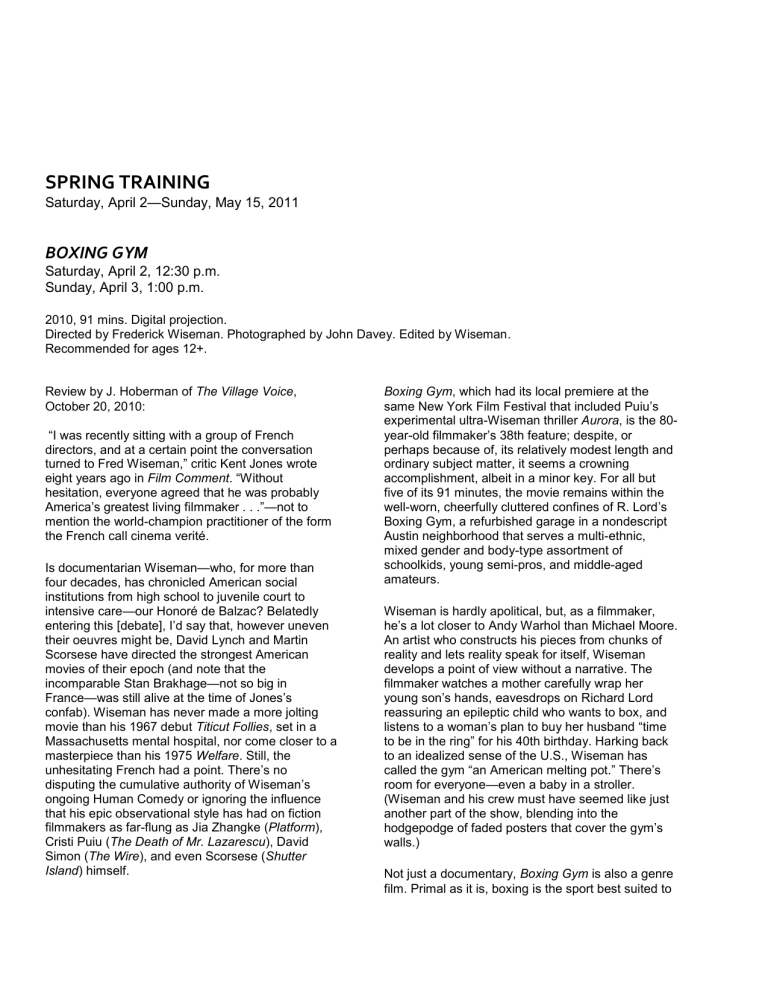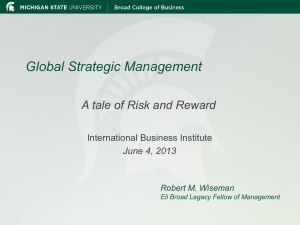the program notes - Museum of the Moving Image

SPRING TRAINING
Saturday, April 2 —Sunday, May 15, 2011
BOXING GYM
Saturday, April 2, 12:30 p.m.
Sunday, April 3, 1:00 p.m.
2010, 91 mins. Digital projection.
Directed by Frederick Wiseman. Photographed by John Davey. Edited by Wiseman.
Recommended for ages 12+.
Review by J. Hoberman of The Village Voice ,
October 20, 2010:
“I was recently sitting with a group of French directors, and at a certain point the conversation turned to Fred Wiseman, ” critic Kent Jones wrote eight years ago in Film Comment . “Without hesitation, everyone agreed that he was probably
America ’s greatest living filmmaker . . .”—not to mention the world-champion practitioner of the form the French cal l cinema verité.
Boxing Gym , which had its local premiere at the same New York Film Festival that included Puiu ’s experimental ultra-Wiseman thriller Aurora , is the 80year-old filmmaker ’s 38th feature; despite, or perhaps because of, its relatively modest length and ordinary subject matter, it seems a crowning accomplishment, albeit in a minor key. For all but five of its 91 minutes, the movie remains within the well-worn, cheerfully cluttered confines of R. Lord ’s
Boxing Gym, a refurbished garage in a nondescript
Austin neighborhood that serves a multi-ethnic, mixed gender and body-type assortment of schoolkids, young semi-pros, and middle-aged amateurs.
Is documentarian Wiseman —who, for more than four decades, has chronicled American social institutions from high school to juvenile court to intensive care —our Honoré de Balzac? Belatedly entering this [debate], I ’d say that, however uneven their oeuvres might be, David Lynch and Martin
Scorsese have directed the strongest American movies of their epoch (and note that the incomparable Stan Brakhage —not so big in
France —was still alive at the time of Jones’s confab). Wiseman has never made a more jolting movie than his 1967 debut Titicut Follies , set in a
Massachusetts mental hospital, nor come closer to a masterpiece than his 1975 Welfare . Still, the unhesitating French had a point. There ’s no disputing the cumulative authority of Wiseman ’s ongoing Human Comedy or ignoring the influence that his epic observational style has had on fiction filmmakers as far-flung as Jia Zhangke ( Platform ),
Cristi Puiu ( The Death of Mr. Lazarescu ), David
Simon ( The Wire ), and even Scorsese ( Shutter
Island ) himself.
Wiseman is hardly apolitical, but, as a filmmaker, he ’s a lot closer to Andy Warhol than Michael Moore.
An artist who constructs his pieces from chunks of reality and lets reality speak for itself, Wiseman develops a point of view without a narrative. The filmmaker watches a mother carefully wrap her young son ’s hands, eavesdrops on Richard Lord reassuring an epileptic child who wants to box, and listens to a woman ’s plan to buy her husband “time to be in the ring ” for his 40th birthday. Harking back to an idealized sense of the U.S., Wiseman has called the gym “an American melting pot.” There’s room for everyone —even a baby in a stroller.
(Wiseman and his crew must have seemed like just another part of the show, blending into the hodgepodge of faded posters that cover the gym ’s walls.)
Not just a documentary, Boxing Gym is also a genre film. Primal as it is, boxing is the sport best suited to
and served by the movies. Boxing Gym effortlessly takes its place beside Body and Soul , The Set-up ,
Champion , Harder They Fall , Requiem for a
Heavyweight , The Great White Hope , Fat City ,
Rocky (sigh), Raging Bull , When We Were Kings ,
Ali , Million Dollar Baby , et al. In fact, by focusing so doggedly on the Bushido of the boxer, Boxing Gym moves close to the head of the class. Narrative and drama are redefined —the movie is more or less a continuous workout. Lord ’s patrons are shown jumping, stretching, crunching, kicking medicine balls, dropping mallets on old tires, and otherwise exercising every muscle they can, the better to maximize their strength, speed, agility, and balance.
Boxing may be the sport of loners, but in this fight club, camaraderie rather than competition is the mode —demonstrated most strenuously in the scene in which six guys leapfrog around the ring. Violence, a frequent Wiseman concern, is presented largely as hearsay —there’s a discussion of the 2007 Virginia
Tech massacre —but only once as personal predilection. “I love getting hit on the chin,” one guy tells another. He enjoys the “buzz.” There’s ample sparring under the direction of the gym ’s avuncular little owner but, emphasizing boxing as discipline rather than contest, Wiseman withholds an actual match until the movie ’s final minutes, and it’s a shock when it comes. However sporting, the slugfest is primitive enough to restore every doubt you might have harbored about the sweet science, but repressed during the course of the film; the adversaries are no longer mastering themselves but inflicting pain on each other. Wiseman, who perhaps harbors doubts himself, uses the fight to make a cosmic segue from the gym to the outside world (if not the universe) as if to note: Such is life on earth.
Boxing Gym is a companion piece of sorts to La
Danse: The Paris Opera Ballet , Wiseman ’s previous doc that played Film Forum last fall. It ’s not simply that boxing and ballet are understood as kindred activities. Boxing Gym is itself a dance movie — which is to say, a highly formalized exercise in choreographed activity. Kinesis is constant.
Whenever there ’s a long shot, Lord’s entire establishment seems to be in motion, like the innards of a vast clock. The most lyrical sequence is a pas de deux featuring a woman in violet crushedvelvet stretch pants and a guy in gray sweats. Never touching but oddly in synch, the parallel pair bounces around the blue-carpeted ring, jabbing at their respective phantom opponents.The blows may be padded, but the beat never stops. As Sam Fuller once said of the scene in which Richard Widmark yanks the fleeing heavy musical.
”
Pickup on South Street in down a flight of subway stairs by his ankles so that his chin hits every step: “ Dat-dat-dat-dat ! It ’s
Museum of the Moving Image is grateful for the generous support of numerous corporations, foundations, and individuals. The
Museum is housed in a building owned by the City of New York and receives significant support from the following public agencies: the New York City Department of Cultural Affairs; New York City Economic Development Corporation; New York
State Council on the Arts; Institute of Museum and Library Services; National Endowment for the Humanities; National
Endowment for the Arts; Natural Heritage Trust (administered by the New York State Office of Parks, Recreation and Historic
Preservation).
Copyright © 2011, Museum of the Moving Image








